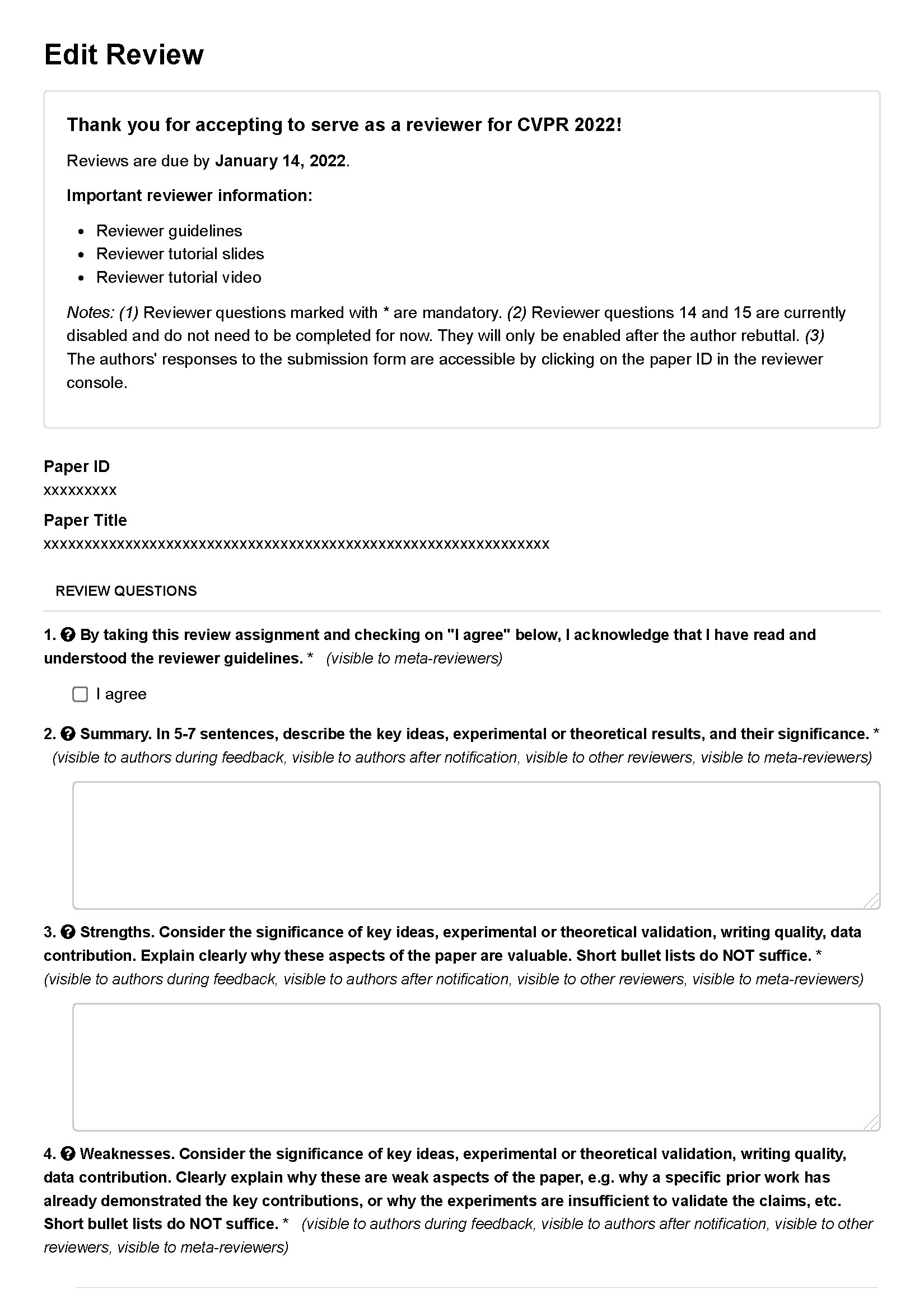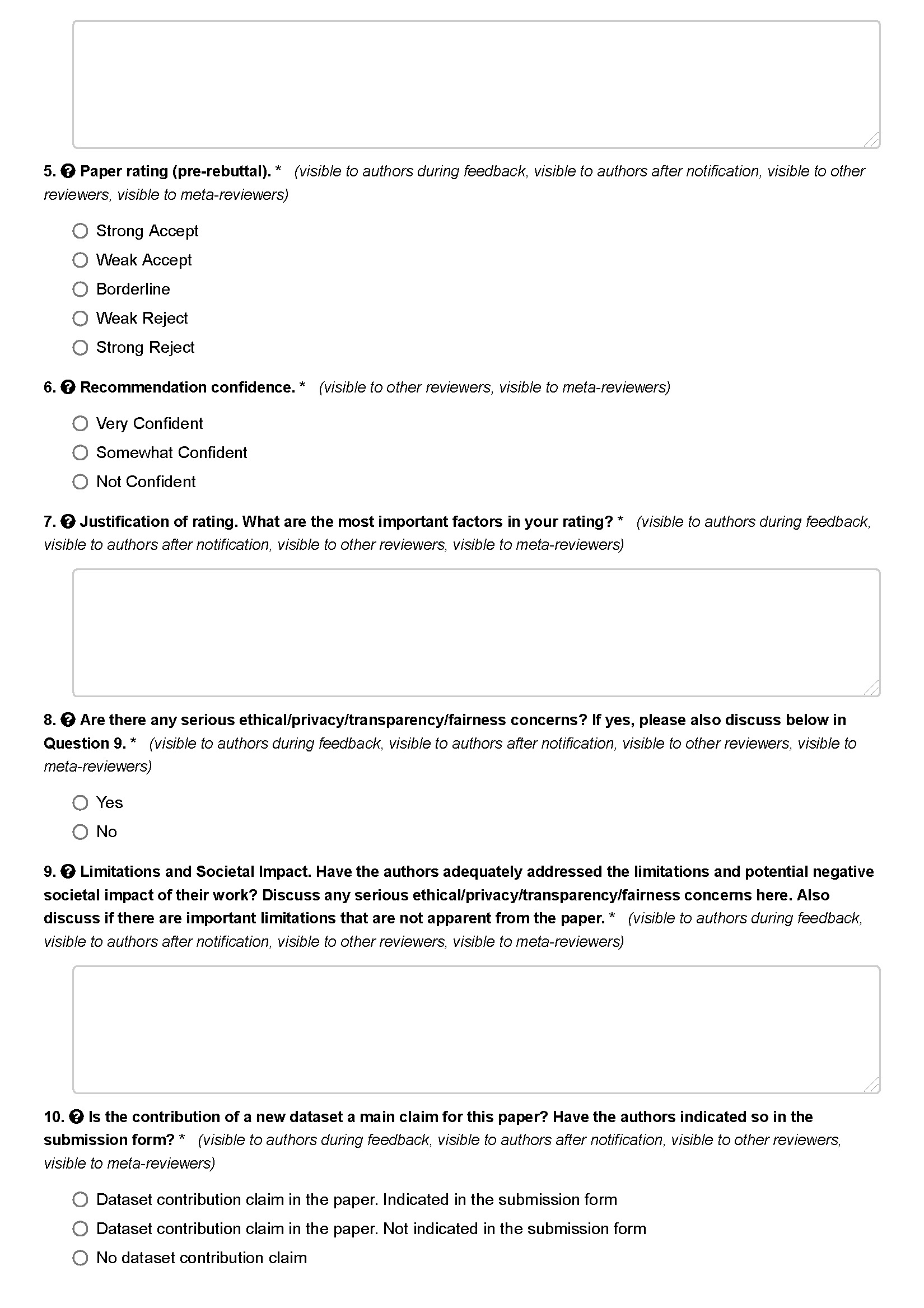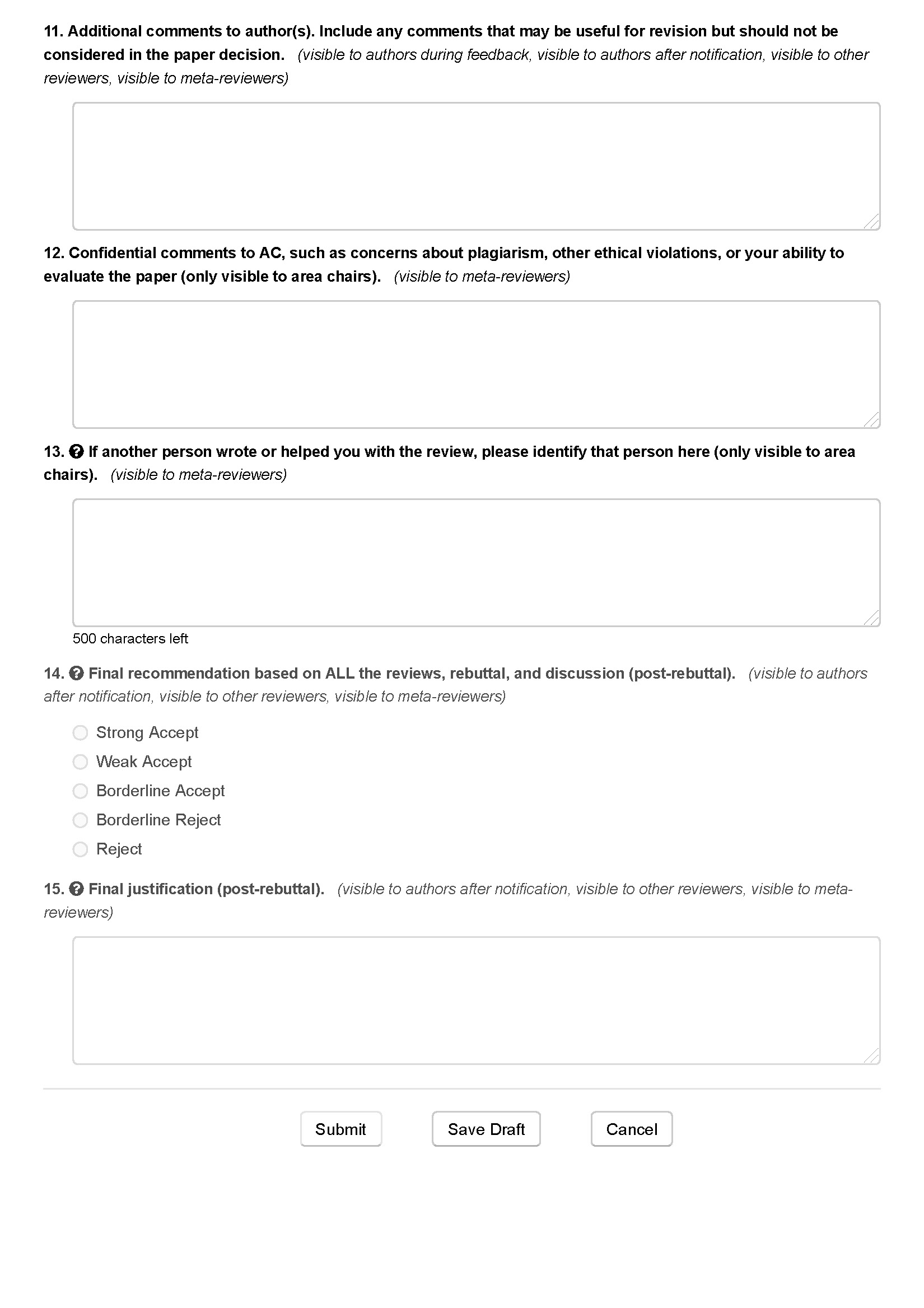CCF A类会议 —— CVPR 2022 论文审稿模板



=============================================
Edit Review
Thank you for accepting to serve as a reviewer for CVPR 2022!
Reviews are due by January 14, 2022. Important reviewer information:
Reviewer guidelines Reviewer tutorial slides Reviewer tutorial video
Notes:
(1) Reviewer questions marked with * are mandatory.
(2) Reviewer questions 14 and 15 are currently disabled and do not need to be completed for now. They will only be enabled after the author rebuttal.
(3) The authors' responses to the submission form are accessible by clicking on the paper ID in the reviewer console.
Paper ID
xxxxxxxxx
Paper Title
xxxxxxxxxxxxxxxxxxxxxxxxxxxxxxxxxxxxxxxxxxxxxxxxxxxxxxxxxxxxxx
REVIEW QUESTIONS
1. By taking this review assignment and checking on "I agree" below, I acknowledge that I have read and understood the reviewer guidelines. * (visible to meta-reviewers)
I agree
2. Summary. In 5-7 sentences, describe the key ideas, experimental or theoretical results, and their significance. *
(visible to authors during feedback, visible to authors after notification, visible to other reviewers, visible to meta-reviewers)
3. Strengths. Consider the significance of key ideas, experimental or theoretical validation, writing quality, data contribution. Explain clearly why these aspects of the paper are valuable. Short bullet lists do NOT suffice. * (visible to authors during feedback, visible to authors after notification, visible to other reviewers, visible to meta-reviewers)
4. Weaknesses. Consider the significance of key ideas, experimental or theoretical validation, writing quality, data contribution. Clearly explain why these are weak aspects of the paper, e.g. why a specific prior work has already demonstrated the key contributions, or why the experiments are insufficient to validate the claims, etc. Short bullet lists do NOT suffice. * (visible to authors during feedback, visible to authors after notification, visible to other reviewers, visible to meta-reviewers)
5. Paper rating (pre-rebuttal). * (visible to authors during feedback, visible to authors after notification, visible to other reviewers, visible to meta-reviewers)
Strong Accept
Weak Accept
Borderline
Weak Reject
Strong Reject
6. Recommendation confidence. * (visible to other reviewers, visible to meta-reviewers)
Very Confident
Somewhat Confident
Not Confident
7. Justification of rating. What are the most important factors in your rating? * (visible to authors during feedback, visible to authors after notification, visible to other reviewers, visible to meta-reviewers)
8. Are there any serious ethical/privacy/transparency/fairness concerns? If yes, please also discuss below in Question 9. * (visible to authors during feedback, visible to authors after notification, visible to other reviewers, visible to meta-reviewers)
Yes
No
9. Limitations and Societal Impact. Have the authors adequately addressed the limitations and potential negative societal impact of their work? Discuss any serious ethical/privacy/transparency/fairness concerns here. Also discuss if there are important limitations that are not apparent from the paper. * (visible to authors during feedback, visible to authors after notification, visible to other reviewers, visible to meta-reviewers)
10. Is the contribution of a new dataset a main claim for this paper? Have the authors indicated so in the submission form? * (visible to authors during feedback, visible to authors after notification, visible to other reviewers, visible to meta-reviewers)
Dataset contribution claim in the paper. Indicated in the submission form
Dataset contribution claim in the paper. Not indicated in the submission form
No dataset contribution claim
11. Additional comments to author(s). Include any comments that may be useful for revision but should not be considered in the paper decision. (visible to authors during feedback, visible to authors after notification, visible to other reviewers, visible to meta-reviewers)
12. Confidential comments to AC, such as concerns about plagiarism, other ethical violations, or your ability to evaluate the paper (only visible to area chairs). (visible to meta-reviewers)
13. If another person wrote or helped you with the review, please identify that person here (only visible to area chairs). (visible to meta-reviewers)
500 characters left
14. Final recommendation based on ALL the reviews, rebuttal, and discussion (post-rebuttal). (visible to authors after notification, visible to other reviewers, visible to meta-reviewers)
Strong Accept
Weak Accept
Borderline Accept
Borderline Reject
Reject
15. Final justification (post-rebuttal). (visible to authors after notification, visible to other reviewers, visible to meta- reviewers)
=========================================
Edit Review
Thank you for accepting to serve as a reviewer for CVPR 2022!
Reviews are due by January 14, 2022. Important reviewer information:
Reviewer guidelines Reviewer tutorial slides Reviewer tutorial video Notes:
(1) Reviewer questions marked with * are mandatory.
(2) Reviewer questions 14 and 15 are currently disabled and do not need to be completed for now. They will only be enabled after the author rebuttal.
(3) The authors' responses to the submission form are accessible by clicking on the paper ID in the reviewer console. Paper ID
xxxxxxxxx
Paper Title
xxxxxxxxxxxxxxxxxxxxxxxxxxxxxxxxxxxxxxxxxxxxxxxxxxxxxxxxxxxxxx REVIEW QUESTIONS 1. By taking this review assignment and checking on "I agree" below, I acknowledge that I have read and understood the reviewer guidelines. * (visible to meta-reviewers) I agree 2. Summary. In 5-7 sentences, describe the key ideas, experimental or theoretical results, and their significance. *
(visible to authors during feedback, visible to authors after notification, visible to other reviewers, visible to meta-reviewers) 3. Strengths. Consider the significance of key ideas, experimental or theoretical validation, writing quality, data contribution. Explain clearly why these aspects of the paper are valuable. Short bullet lists do NOT suffice. * (visible to authors during feedback, visible to authors after notification, visible to other reviewers, visible to meta-reviewers) 4. Weaknesses. Consider the significance of key ideas, experimental or theoretical validation, writing quality, data contribution. Clearly explain why these are weak aspects of the paper, e.g. why a specific prior work has already demonstrated the key contributions, or why the experiments are insufficient to validate the claims, etc. Short bullet lists do NOT suffice. * (visible to authors during feedback, visible to authors after notification, visible to other reviewers, visible to meta-reviewers) 5. Paper rating (pre-rebuttal). * (visible to authors during feedback, visible to authors after notification, visible to other reviewers, visible to meta-reviewers)
Strong Accept
Weak Accept
Borderline
Weak Reject
Strong Reject 6. Recommendation confidence. * (visible to other reviewers, visible to meta-reviewers) Very Confident
Somewhat Confident
Not Confident 7. Justification of rating. What are the most important factors in your rating? * (visible to authors during feedback, visible to authors after notification, visible to other reviewers, visible to meta-reviewers) 8. Are there any serious ethical/privacy/transparency/fairness concerns? If yes, please also discuss below in Question 9. * (visible to authors during feedback, visible to authors after notification, visible to other reviewers, visible to meta-reviewers) Yes
No 9. Limitations and Societal Impact. Have the authors adequately addressed the limitations and potential negative societal impact of their work? Discuss any serious ethical/privacy/transparency/fairness concerns here. Also discuss if there are important limitations that are not apparent from the paper. * (visible to authors during feedback, visible to authors after notification, visible to other reviewers, visible to meta-reviewers) 10. Is the contribution of a new dataset a main claim for this paper? Have the authors indicated so in the submission form? * (visible to authors during feedback, visible to authors after notification, visible to other reviewers, visible to meta-reviewers) Dataset contribution claim in the paper. Indicated in the submission form
Dataset contribution claim in the paper. Not indicated in the submission form
No dataset contribution claim 11. Additional comments to author(s). Include any comments that may be useful for revision but should not be considered in the paper decision. (visible to authors during feedback, visible to authors after notification, visible to other reviewers, visible to meta-reviewers) 12. Confidential comments to AC, such as concerns about plagiarism, other ethical violations, or your ability to evaluate the paper (only visible to area chairs). (visible to meta-reviewers) 13. If another person wrote or helped you with the review, please identify that person here (only visible to area chairs). (visible to meta-reviewers) 500 characters left 14. Final recommendation based on ALL the reviews, rebuttal, and discussion (post-rebuttal). (visible to authors after notification, visible to other reviewers, visible to meta-reviewers)
Strong Accept
Weak Accept
Borderline Accept
Borderline Reject
Reject 15. Final justification (post-rebuttal). (visible to authors after notification, visible to other reviewers, visible to meta- reviewers)
=========================================
CCF A类会议 —— CVPR 2022 论文审稿模板的更多相关文章
- 跟我读CVPR 2022论文:基于场景文字知识挖掘的细粒度图像识别算法
摘要:本文通过场景文字从人类知识库(Wikipedia)中挖掘其背后丰富的上下文语义信息,并结合视觉信息来共同推理图像内容. 本文分享自华为云社区<[CVPR 2022] 基于场景文字知识挖掘的 ...
- 论文解读丨【CVPR 2022】不使用人工标注提升文字识别器性能
摘要:本文提出了一种针对文字识别的半监督方法.区别于常见的半监督方法,本文的针对文字识别这类序列识别问题做出了特定的设计. 本文分享自华为云社区<[CVPR 2022] 不使用人工标注提升文字识 ...
- CVPR 2022数据集汇总|包含目标检测、多模态等方向
前言 本文收集汇总了目前CVPR 2022已放出的一些数据集资源. 转载自极市平台 欢迎关注公众号CV技术指南,专注于计算机视觉的技术总结.最新技术跟踪.经典论文解读.CV招聘信息. M5Produc ...
- [NISPA类会议] 怎样才能在NIPS 上面发论文?
cp from : https://www.zhihu.com/question/49781124?from=profile_question_card https://www.reddit.com/ ...
- [国际A类会议] 2018最最最顶级的人工智能国际峰会汇总!CCF推荐!
copy from : http://www.sohu.com/a/201860341_99975651 如果今年的辉煌我们没有赶上,那么我们可以提前为明年的大会做准备.现在,AI脑力波小编就为大家 ...
- [A类会议] 国内论文检索
https://www.cn-ki.net/ http://www.koovin.com
- [Z] 计算机类会议期刊根据引用数排名
一位cornell的教授做的计算机类期刊会议依据Microsoft Research引用数的排名 link:http://www.cs.cornell.edu/andru/csconf.html Th ...
- CVPR 2019 论文解读 | 小样本域适应的目标检测
引文 最近笔者也在寻找目标检测的其他方向,一般可以继续挖掘的方向是从目标检测的数据入手,困难样本的目标检测,如检测物体被遮挡,极小人脸检测,亦或者数据样本不足的算法.这里笔者介绍一篇小样本(few ...
- CVPR 2020论文收藏(转知乎:https://zhuanlan.zhihu.com/p/112337176)
CVPR 2020 共收录 1470篇文章,根据当前的公布情况,人工智能学社整理了以下约100篇,分享给读者. 代码开源情况:详见每篇注释,当前共15篇开源.(持续更新中,可关注了解). 算法主要领域 ...
- myhuiban会议,期刊,科研人员,计算机类会议大全
http://www.myhuiban.com/ List of computer science conferences From Wikipedia, the free encyclopedia ...
随机推荐
- json LocalDateTime转对象
json LocalDateTime转对象 feign.codec.DecodeException: JSON parse error: Can not deserialize instance of ...
- Nuxt3页面开发实战探索
title: Nuxt3页面开发实战探索 date: 2024/6/19 updated: 2024/6/19 author: cmdragon excerpt: 摘要:这篇文章是关于Nuxt3页面开 ...
- EyeLink 1000 plus(桌面式)眼动仪使用指导
一.简介 眼动追踪是测量眼睛运行的过程.眼动追踪研究的最关注的事件是确定人类或者动物看的地方(比如:"注视点"或"凝视点").更准确来说是通过仪器设备进行图像处 ...
- windows系统安装或使用inspect.exe工具
确认是否安装? 结合工具everything,进行搜索 选择对应操作系统的版本,右键->选择打开路径,进到inspect.exe的安装路径,双击打开软件 软件开启后,就会自动开始抓取目前软件界面 ...
- python selenium使用无头模式执行用例
什么是无头模式? Headless Browser模式是浏览器的无界面状态,即在不打开浏览器界面的情况下使用浏览器. 该模式的好处如下: 1)可以加快web自动化测试的执行时间,对于web自动化测试, ...
- 基于 tc 指令的网速限制工具
前言 最近有一个需求,需要限制网卡速度进行一些测试.在朋友推荐下阅读了这篇文章 TC简单粗暴限制网速. 经过尝试,简单有效,整理成脚本放在正文,留作参考. 正文 指令解析(chatgpt 分析) 您提 ...
- Ez Forensics详解
Ez Forensics详解 题目要求: 数据库版本 + 字符集格式 + 最长列名 示例:NSSCTF 步骤: 解压压缩包得到forensics.vmdk,.vmdk是虚拟机磁盘文件的元数据文件 可以 ...
- SpringBoot实现单机锁和分布式锁
1.使用Java的内置锁机制(单机锁) Java提供了synchronized关键字和java.util.concurrent.locks.Lock接口来实现锁. synchronized是Java语 ...
- react上传文件显示上传进度
Axios 是一个基于 promise 的 HTTP 库,可以用在浏览器和 node.js 中.在使用react, vue框架的时候, 如果需要监听文件上传可以使用axios里的onUploadPro ...
- vue中的插槽详解
插槽(slot)插槽在vue中是一种很常见的写法,让父组件可以向子组件指定位置插入html结构,也是一种组件间通信的方式 一共有三种分类:默认插槽.具名插槽.作用域插槽,下面一一根据案例改造说明 1 ...
